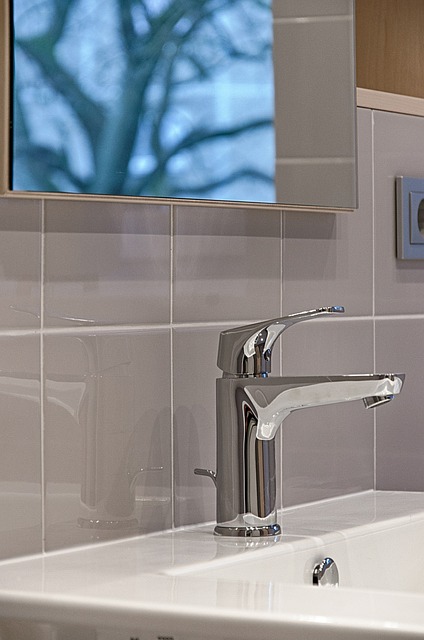Sustainable bathroom design prioritizes ventilation to combat humidity, mold, and poor air quality, enhancing well-being and energy efficiency. Key strategies include natural ventilation through windows or exhaust fans, using low VOC materials like bamboo or recycled glass, and installing energy-efficient exhaust systems. Proper ventilation prevents mold growth, improves indoor air quality, reduces energy consumption, and offers long-term health benefits, making it an essential component of eco-conscious bathroom design.
Maintaining a healthy living environment starts with understanding ventilation—a key factor often overlooked. This article delves into the importance of proper ventilation, focusing on its role in creating a balanced and sustainable indoor climate. We explore specific aspects like sustainable bathroom design, addressing common issues and offering effective solutions to ensure optimal air quality. By implementing these strategies, you’ll uncover long-term benefits that promote overall well-being and create healthier homes, particularly through innovative sustainable bathroom design approaches.
Understanding Ventilation: The Key to Healthy Living
Ventilation is a fundamental aspect of creating and maintaining healthy living spaces, especially in modern homes with sealed structures. In the context of sustainable bathroom design, proper ventilation plays a crucial role in ensuring optimal air quality. Bathrooms, often humid and warm environments due to regular showering and bathing, require efficient ventilation systems to prevent moisture buildup and associated issues like mold growth and poor air quality.
Effective ventilation not only addresses these immediate concerns but also contributes to overall well-being and energy efficiency. Well-designed bathroom ventilation systems can help regulate temperature, reduce the presence of harmful volatile organic compounds (VOCs) from cleaning products or furniture, and ensure a constant supply of fresh air. This is particularly important as we spend a significant amount of time in our bathrooms, making proper ventilation a key element in creating healthy and sustainable living spaces.
Sustainable Bathroom Design: A Green Approach
Incorporating sustainable practices into bathroom design is not just an eco-friendly choice, but also a strategic move to enhance indoor air quality and overall health. Sustainable bathroom design emphasizes natural ventilation, making use of well-placed windows or exhaust fans to regulate humidity levels and air circulation. This approach not only reduces energy consumption associated with artificial ventilation systems but also minimizes the risk of mold growth, which thrives in damp environments.
Additionally, sustainable bathroom design often incorporates materials with low volatile organic compound (VOC) emissions, such as bamboo, recycled glass, or linoleum. These natural and eco-friendly options contribute to better air quality by preventing harmful chemicals from off-gassing into the living space. By embracing a green approach in bathroom design, we not only create healthier environments but also take a step towards preserving our planet’s resources for future generations.
Common Ventilation Issues in Bathrooms
In many homes, bathrooms often become trapped spaces with poor ventilation, leading to a buildup of moisture and humidity. This can result in various issues, from mold growth on walls and ceilings to a constant musty smell and even damage to structural elements over time. In the context of sustainable bathroom design, addressing these common ventilation problems is essential for creating a healthy living environment.
One primary challenge is inadequate exhaust fans or their improper placement. Fans that are too small or not correctly positioned above shower stalls or bath areas fail to effectively remove damp air, causing condensation and potential water damage. Modern solutions advocate for energy-efficient, smart exhaust fans that can be programmed to operate only when needed, enhancing comfort while conserving energy—a key aspect of sustainable bathroom design.
Effective Solutions for Optimal Air Quality
In the pursuit of a healthy and comfortable living environment, especially within spaces like bathrooms, proper ventilation plays a pivotal role in maintaining optimal air quality. A well-designed sustainable bathroom incorporates strategic ventilation solutions that not only mitigate moisture buildup but also ensure the efficient circulation of fresh air. This dual approach is key to preventing the cultivation of mold, bacteria, and other allergens while enhancing overall indoor air quality.
One effective strategy involves the integration of mechanical ventilation systems, such as exhaust fans or more advanced heat recovery ventilators (HRVs). These systems actively remove stagnant, humid air and replace it with fresh outdoor air, significantly reducing moisture levels and improving airflow. Additionally, designing bathrooms with multiple ventilation outlets—including windows and vents—allows for natural cross-ventilation, further contributing to a healthier atmosphere. For eco-conscious designs, incorporating natural ventilation methods, like strategically placed openings and passive cooling techniques, offers a sustainable alternative while maintaining the same level of air quality.
Long-term Benefits of Proper Ventilation
Proper ventilation isn’t just about fresh air; it’s a long-term investment in your health and well-being, especially within the confines of your bathroom. In the context of sustainable bathroom design, effective ventilation reduces moisture buildup, preventing mould and mildew growth. This is crucial for maintaining indoor air quality, as stagnant, humid air can harbour bacteria and viruses, leading to respiratory issues over time.
A well-ventilated bathroom also contributes to energy efficiency. By allowing heat to escape during cooling seasons and keeping warm air in during heating periods, proper ventilation reduces the workload on HVAC systems. This not only saves energy but also translates to cost savings on utility bills, making it a key component of any eco-friendly and sustainable bathroom design strategy.
Proper ventilation is not just a luxury, but an essential component of sustainable bathroom design. By addressing common issues and implementing effective solutions, we can ensure optimal air quality and reap long-term benefits for our health and well-being. Embracing these practices isn’t just about maintaining a healthy environment; it’s about fostering a peaceful, invigorating sanctuary within our homes.
